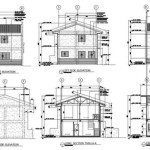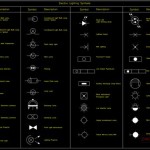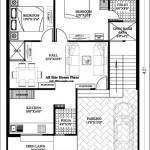3600 Sqft 2-Story House Plans With Dimensions In Inches
Designing a home involves intricate planning, especially when aiming for a specific size and structure. For a 3600 sqft 2-story house, detailed plans with dimensions in inches are crucial for accurate construction and to ensure the final product aligns with the homeowner's vision. These plans serve as a blueprint, guiding architects, contractors, and builders through every phase of the project, from foundation laying to interior finishing. Accuracy in dimensions is paramount to avoid costly errors and rework during construction. This article delves into the key considerations and essential elements of 3600 sqft 2-story house plans, emphasizing the importance of precise dimensions.
The overall layout of a 3600 sqft 2-story house provides ample space for various living areas, bedrooms, bathrooms, and storage. The distribution of this space between the two floors will significantly impact the usability and functionality of the home. Common layouts include dedicating the ground floor to living, dining, and kitchen areas, alongside a possible guest room or home office, while the upper floor houses the master suite and additional bedrooms. Factors such as the size of the lot, orientation to the sun, and local building codes will influence the optimal layout.
The advantage of having dimensions in inches is the enhanced precision during the construction process. Metric measurements can be converted, but retaining the original measurements in inches eliminates a potential source of rounding errors. These minute discrepancies can accumulate, leading to misalignments in walls, doors, and windows, impacting the aesthetic appeal and structural integrity. Accurate inch-based dimensions ensure that every component fits seamlessly, reducing waste and minimizing the need for on-site adjustments.
Importance of Detailed Floor Plans
Floor plans form the backbone of any house design. For a 3600 sqft 2-story house, these plans must encompass every detail of each floor, including wall placements, door and window sizes and locations, staircase dimensions, and utility access points. Dimensions in inches provide the necessary precision for contractors to accurately frame walls, install doors and windows, and run electrical and plumbing lines. The floor plan should also indicate the intended use for each room, which helps in planning for furniture placement and optimizing space utilization. Detailed floor plans also facilitate better communication between the design team and the construction crew, minimizing misunderstandings and ensuring that the final product reflects the approved design.
When reviewing floor plans, consider the flow of movement within the house. Ideally, the layout should allow for easy and efficient movement between different living areas. The positioning of the kitchen in relation to the dining area, the proximity of bedrooms to bathrooms, and the location of the laundry room are all critical factors that contribute to the overall functionality of the house. The floor plan should also clearly denote the location and size of structural elements such as load-bearing walls and support columns. These elements are crucial for maintaining the structural integrity of the house, and any modifications to their placement must be carefully evaluated by a structural engineer.
In addition to the room layouts, the floor plans should also include details about interior features such as built-in shelves, fireplaces, and cabinetry. Precise dimensions are essential for these features to ensure they fit seamlessly into the design and meet the homeowner's aesthetic preferences. Electrical outlets, light switches, and plumbing fixtures should also be clearly indicated on the floor plans, along with their respective dimensions. This ensures that these elements are installed in the correct locations and that they are easily accessible.
Key Elements in 3600 Sqft Home Designs
A 3600 sqft 2-story house provides opportunities for expansive living spaces and comfortable private quarters. Here are some key elements often incorporated into such designs:
*Living Areas:
A large living room, perhaps with a fireplace, serves as a central gathering place. Incorporating large windows allows for ample natural light and can create an inviting atmosphere. The dimensions of the living room should be carefully considered to accommodate furniture arrangements and traffic flow. *Kitchen and Dining:
An open-concept kitchen seamlessly flowing into a dining area is a popular choice. A kitchen island serves as a focal point, and dimensions must account for appliance sizes, countertop space, and storage solutions. Separate dining rooms can also be implemented. *Bedrooms and Bathrooms:
A master suite with a walk-in closet and ensuite bathroom, complete with double vanities and a separate shower and tub, is a standard feature. Additional bedrooms, along with shared or individual bathrooms, cater to family members or guests. The dimensions of these rooms should be sufficient to accommodate furniture and provide comfortable living spaces. *Home Office:
With the rise of remote work, a dedicated home office is becoming increasingly desirable. The dimensions of the office should be conducive to focused work, with adequate space for a desk, chair, and storage. *Garage:
Most 3600 sqft homes include a 2 or 3-car garage. The dimensions of the garage should be large enough to accommodate vehicles with ease and provide storage space for tools and equipment. *Outdoor Spaces:
Patios, decks, or porches extend the living space outdoors. The dimensions of these areas should be proportional to the size of the house and should complement the overall design.Incorporating these elements into the 3600 sqft design requires careful planning and attention to detail. Each element must be carefully considered in terms of its size, location, and functionality. The dimensions of each room and feature should be clearly indicated on the floor plans, ensuring that the construction team has the information they need to build the house according to the approved design.
Considerations for Exterior Dimensions
Exterior dimensions are just as critical as interior dimensions. They define the footprint of the house on the property and influence the overall aesthetic appeal. The lot size, setbacks, and easements are all factors that influence the permissible exterior dimensions. Accurate exterior dimensions ensure compliance with local building codes and prevent encroachment on neighboring properties.
The exterior dimensions also dictate the roof design, overhangs, and the placement of windows and doors. The roof design should be aesthetically pleasing and functional, protecting the house from the elements. The overhangs should be sized appropriately to provide shade and protect the exterior walls from rain. The placement of windows and doors should maximize natural light and ventilation while maintaining privacy and security.
The exterior dimensions also influence the landscaping plan. The landscaping should complement the design of the house and create a harmonious connection between the house and its surroundings. The dimensions of the landscaping features, such as patios, walkways, and gardens, should be carefully considered to ensure they are proportionate to the size of the house and the lot.
The accuracy of exterior dimensions is paramount to the success of the construction project. Errors in exterior dimensions can lead to costly delays and rework. It is essential to work with experienced architects and contractors who are familiar with local building codes and regulations. They can help ensure that the exterior dimensions of the house comply with all applicable requirements and that the house is built according to the approved design.
For example, consider the foundation. The foundation dimensions need to precisely match the dimensions of the exterior walls. Any discrepancy can lead to structural instability and costly repairs. Similarly, the roof dimensions need to be accurate to ensure proper drainage and prevent water damage. The placement of windows and doors needs to be precise to ensure proper sealing and prevent air leaks. These are just a few examples of how accurate exterior dimensions are critical to the overall success of the construction project.
Furthermore, the exterior dimensions also impact the energy efficiency of the house. The placement of windows and doors can influence the amount of solar heat gain that enters the house. The size and orientation of the house can affect the amount of energy required to heat and cool the house. Careful consideration of these factors during the design phase can help reduce energy consumption and lower utility bills.
In conclusion, accurate dimensions in inches are not just a detail but a fundamental requirement for a successful 3600 sqft 2-story house construction. They ensure precision, minimize errors, facilitate clear communication, and contribute to the overall functionality and aesthetic appeal of the home. Investing in detailed and accurate plans is an investment in the long-term quality and value of the house.

House Plan Ch225

House Plan 6 Bedrooms 4 Bathrooms Garage 3600 Drummond Plans

House Plan 5 Bedrooms 3 Bathrooms Garage 3890 Drummond Plans

House Plans Home Custom
How Many Floors Can Be Built In A 3600 Square Feet Area Quora

Floor Plans Archives Hansen Buildings

French Country Floor Plan 3 Bed 2 1 Bath Single Story 600sq Ft

House Plan Ch149

Barndominium Plans Stock And Custom Pictures Faqs Tips

The Ideal House Size And Layout To Raise A Family








